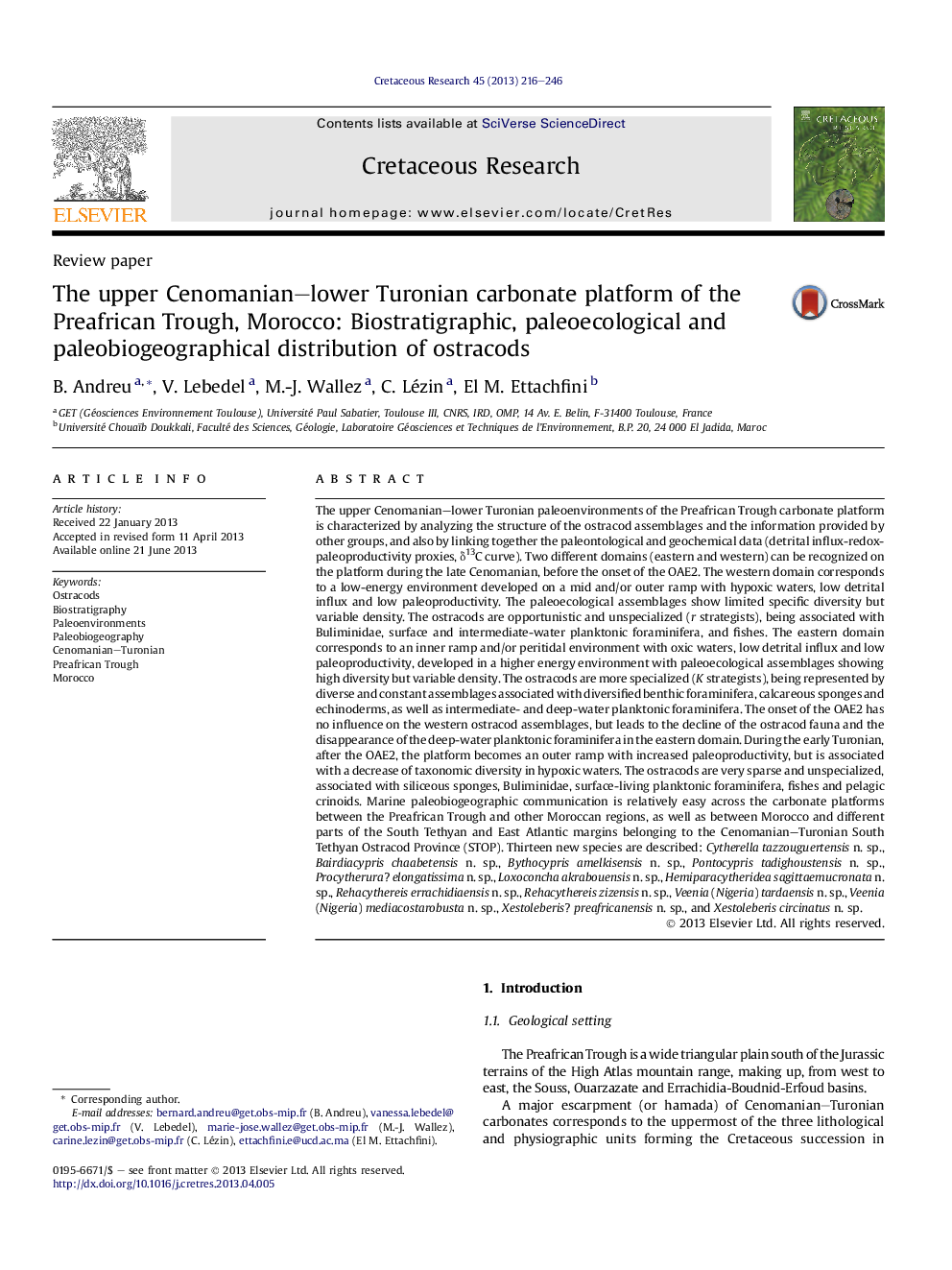| کد مقاله | کد نشریه | سال انتشار | مقاله انگلیسی | نسخه تمام متن |
|---|---|---|---|---|
| 4747303 | 1642077 | 2013 | 31 صفحه PDF | دانلود رایگان |

• Study of ostracods and other paleontological groups linked with geochemical proxies.
• Highlighting of paleoecology and paleoenvironmental conditions on the platform.
• Paleobiogeographical marine communication in the North of Africa.
• Description of thirteen new species in the late Cenomanian–early Turonian interval.
The upper Cenomanian–lower Turonian paleoenvironments of the Preafrican Trough carbonate platform is characterized by analyzing the structure of the ostracod assemblages and the information provided by other groups, and also by linking together the paleontological and geochemical data (detrital influx-redox-paleoproductivity proxies, δ13C curve). Two different domains (eastern and western) can be recognized on the platform during the late Cenomanian, before the onset of the OAE2. The western domain corresponds to a low-energy environment developed on a mid and/or outer ramp with hypoxic waters, low detrital influx and low paleoproductivity. The paleoecological assemblages show limited specific diversity but variable density. The ostracods are opportunistic and unspecialized (r strategists), being associated with Buliminidae, surface and intermediate-water planktonic foraminifera, and fishes. The eastern domain corresponds to an inner ramp and/or peritidal environment with oxic waters, low detrital influx and low paleoproductivity, developed in a higher energy environment with paleoecological assemblages showing high diversity but variable density. The ostracods are more specialized (K strategists), being represented by diverse and constant assemblages associated with diversified benthic foraminifera, calcareous sponges and echinoderms, as well as intermediate- and deep-water planktonic foraminifera. The onset of the OAE2 has no influence on the western ostracod assemblages, but leads to the decline of the ostracod fauna and the disappearance of the deep-water planktonic foraminifera in the eastern domain. During the early Turonian, after the OAE2, the platform becomes an outer ramp with increased paleoproductivity, but is associated with a decrease of taxonomic diversity in hypoxic waters. The ostracods are very sparse and unspecialized, associated with siliceous sponges, Buliminidae, surface-living planktonic foraminifera, fishes and pelagic crinoids. Marine paleobiogeographic communication is relatively easy across the carbonate platforms between the Preafrican Trough and other Moroccan regions, as well as between Morocco and different parts of the South Tethyan and East Atlantic margins belonging to the Cenomanian–Turonian South Tethyan Ostracod Province (STOP). Thirteen new species are described: Cytherella tazzouguertensis n. sp., Bairdiacypris chaabetensis n. sp., Bythocypris amelkisensis n. sp., Pontocypris tadighoustensis n. sp., Procytherura? elongatissima n. sp., Loxoconcha akrabouensis n. sp., Hemiparacytheridea sagittaemucronata n. sp., Rehacythereis errachidiaensis n. sp., Rehacythereis zizensis n. sp., Veenia (Nigeria) tardaensis n. sp., Veenia (Nigeria) mediacostarobusta n. sp., Xestoleberis? preafricanensis n. sp., and Xestoleberis circinatus n. sp.
Figure optionsDownload as PowerPoint slide
Journal: Cretaceous Research - Volume 45, October 2013, Pages 216–246